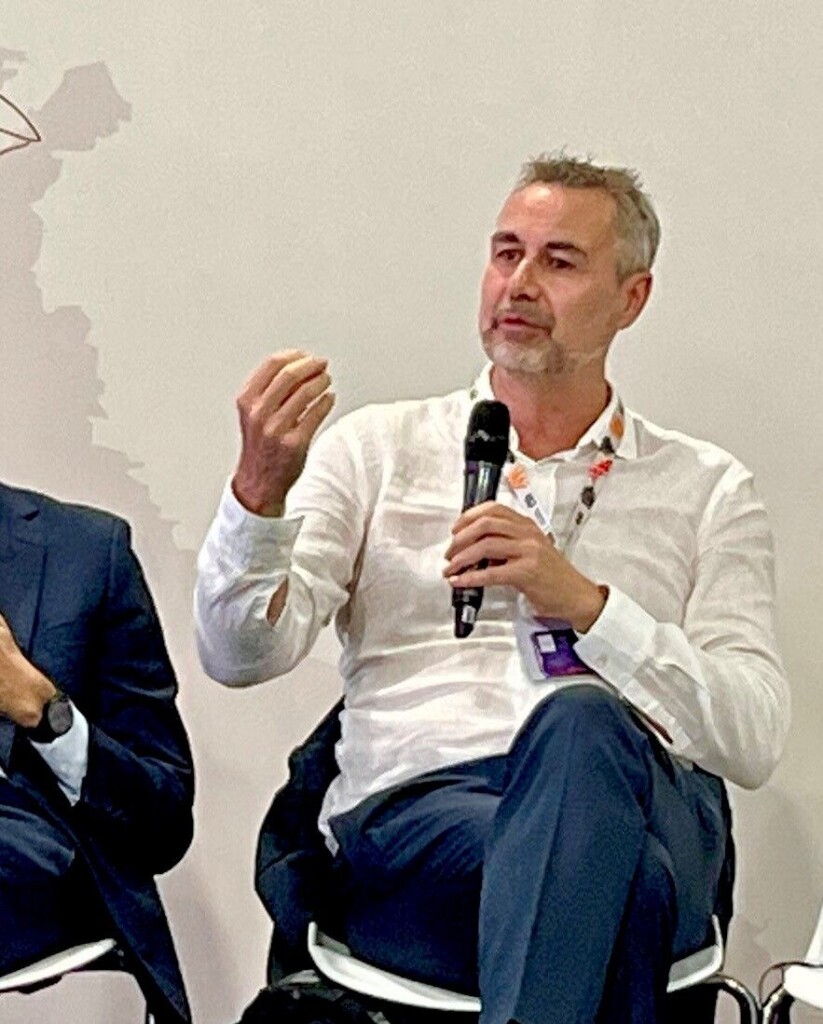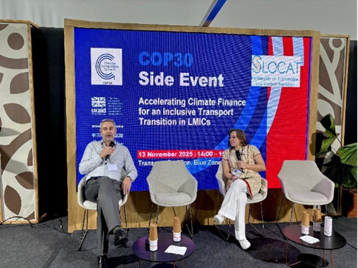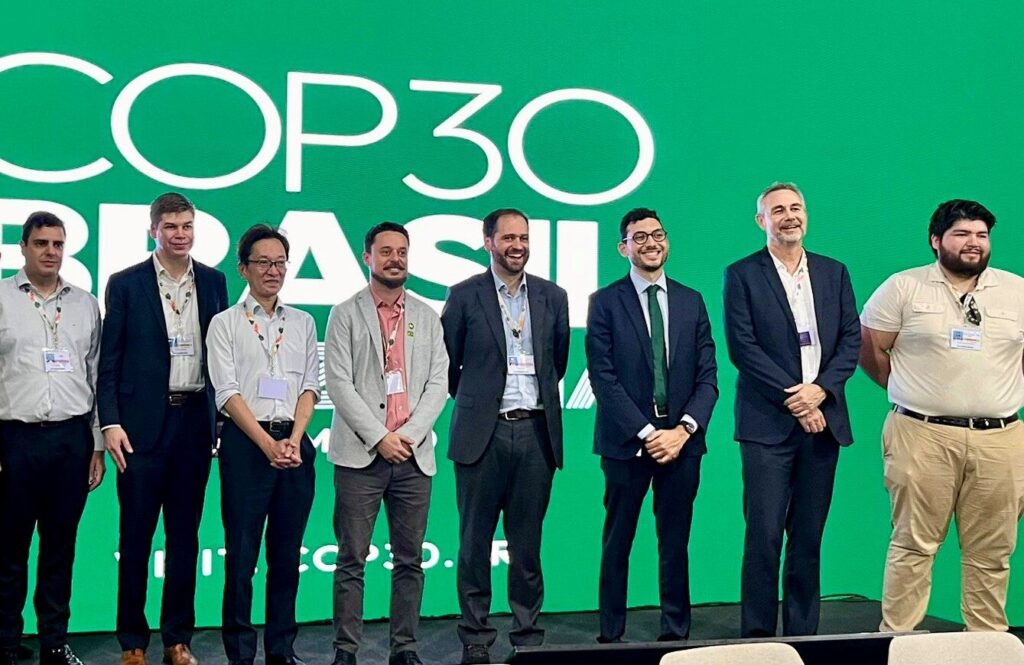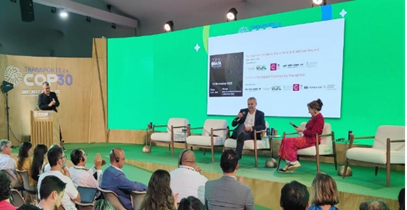
Holger Dalkmann, CCG’s Sustainable Transport Lead, reflects on a very busy time for CCG at this year’s COP.
COP30 in Belém drew about 50,000 people and, while questions remain about whether that attention was carbon‑well‑spent, many locals and Brazilian colleagues I spoke with warmly welcomed the focus on the region and the chance to bring the lived experience of climate change closer to the public.
I had the pleasure of joining the small CCG delegation to share the consortium’s work on data-to-deal, climate finance and the link to the upcoming UN Decade of Sustainable Transport, engaging with policy makers and the wider transport and climate community.
The negotiations produced both advances and setbacks. In the final days of COP, the Fossil Fuel phase‑out roadmap briefly gained momentum after President Lula’s opening speech and more than 90 countries signalled support; pressure from a group of 24 countries then intensified when the Presidency did not include a reference to fossil fuel in the final text. A conference on fossil fuel phase-out, co-hosted by Columbia and the Netherlands, is planned for April next year and should be watched for its potential to feed into COP31 particularly as Australia as COP negotiation lead is part of the alliance.
For transport, COP30 delivered several concrete developments. Chile, led by Transport Minister Carlos Muñoz drawing on his former role at the International Transport Forum, spearheaded an initiative for a Global Transport Goal achieving globally by 2035 a quarter drop in overall energy demand and shifting to one- third sustainable biofuels and renewable sources considering each country’s contribution. eleven countries signed the initial call, signalling political interest in elevating the sector in climate discussions.
Under the leadership of the Brazilian Presidency a revised Global Action Agenda in the form of six new Activation Groups was formed to design mechanisms to bring governmental and non‑governmental stakeholders together around sectoral action, including one on Industry, energy and transport. A wide range of extended or new commitments were shared. For example, Transport decarbonization in India, Mexico and Europe deploying Zero emissions trucks and establishing new renewable energy supply.
Data and capacity building were prominent themes across the Pavilion and side events. CCG presented the Data-to-Deal approach, which has been applied in Costa Rica and other Latin American countries enabling access to over 11bn USD, and launched seven policy briefs to support LMICs; four pilot countries in Asia will follow in partnership with the Asian Development Bank.



The Transport Data Commons Initiative (TDCI), a partnership of over 30 international organizations including CCG, offered a practical pathway to open, accessible data as a foundation for NDC implementation, tracking, and climate finance access. These initiatives underline that better data and stronger capacity are prerequisites for credible planning and finance readiness.
Finance signals were mixed but important. New funding windows of existing initiatives such as the Mitigation Action Facility (MAF) and the German International Climate Initiative (IKI) thematic calls were launched creating ongoing sources of support for sustainable mobility.
At this COP, the decision was made to triple global adaptation finance against the goal set in Glasgow, setting a target of COP30 Action Agenda_Final Report.docx of $120 billion annually. Multilateral Development Banks (MDBs) outlined their own role: while their adaptation commitments are not sector‑specific, they were presented as potentially strengthening transport resilience. MDBs announced plans to triple their financing for resilience over the next decade, aiming to mobilize $42 billion by 2030.

Private‑sector engagement was visible, and proposals to make carbon markets work for public transport and rail reappeared after decades of limited progress. Conversations about carbon markets resurfaced with proposals from UIC and UITP to redesign Article 6 mechanisms to better support public transport and rail. Yet the finance gap remains large: access to funds, project readiness, and alignment with public‑interest goals continue to be major barriers for many countries and cities.
Brazil played a central role in shaping the transport presence at COP30. National and local initiatives presented such as a new Mitigation Action Facility funded work establishing a new fund to accelerate the decarbonisation of public transport by WRI Brazil, ITDP with a specific emphasis on gender or the launch of Brazil’s freight corridor and other national actions demonstrated how country‑level leadership can translate into tangible projects the others illustrated how climate and development objectives can be combined in practice.
The Transport Pavilion – organised by SLOCAT in partnership with the Brazilian Ministry of Transport, CNT, CCG and other international partners – became the go‑to place for the transport and climate community, hosting numerous events in the blue zone. The first ever Transport Pavilion at COP30 was certainly a milestone and brought together practitioners, researchers, civil society and government representatives and helped bridge technical discussions with lived experience. But also the green zone, which was open to the public showed strong civil society engagement in the transport sector.

Despite the visibility and new initiatives, the sector’s overall trajectory remains worrying. Transport is still the fastest‑growing sources of emissions and, without substantial interventions, is not on track to align with Paris goal, which would require according to IPCC at 59% reduction against a BAU, while current polices would lead to an increase of 10% by 2030. By the end of COP30, 119 nations had stepped forward with new NDCs, covering roughly three‑quarters of global emissions. The pledges mark incremental progress – signalling movement on emission cuts and sector‑level initiatives, but the collective impact remains limited. According to the UN, all taken together, they achieve less than 15% of the reductions needed by 2035 to keep the world on track for the 1.5°C goal. An analysis by SLOCAT just before COP30 showed some progress with over 90% of the submitted NDC made reference to transport, transport targets and action in many NDCs remain under‑specified or insufficiently ambitious. With the launch of the a Global Implementation Accelerator led by Brazil, Azerbaijan and Turkey, as an outcome of COP aiming for increased ambitions by countries throughout this year, is a crucial opportunity to increase activities within the sector.
New coordination mechanisms such as country platforms gained more attention as potential bottom‑up ways to align country and donor engagement. These platforms could change how transport is integrated into broader climate and development planning, but there is a real risk that transport will remain peripheral unless it is explicitly included in donor and country plans – similar to past experiences with JETP‑style mechanisms.
So where does this leave us?
COP30 left a mixed but actionable picture: a visible Transport Pavilion, a nascent Global Transport Goal, evolving activation groups, data and capacity initiatives, and continuing finance windows. The core challenge remains implementation – turning declarations into detailed, bankable roadmaps, and roadmaps into funded projects that deliver measurable emissions reductions and improved access.
To move forward the transport community should build on existing NDC and use the year to scale data and capacity‑building initiatives such as from UNECE, UNESCAP and many others, so LMICs can improve their plans including finance transitions; redesign finance instruments to be accessible to public actors, and ensure transport is explicitly integrated into country platforms and donor coordination.
The UN Decade of Sustainable Transport and the upcoming next global stocktake cycle by 2028 provide concrete opportunities to link climate and sustainable development agendas. The UN Decade launch in New York on 10 December will be an important moment to do so. The Columbia conference on fossil phase‑out planned for next year should also be watched for its potential to shape the roadmap debate further into the coming COP to be hosted by Turkey.
Finally, a personal note of thanks: the Transport Pavilion and the wider transport presence at COP30 were only possible because of the hard work of many partners. Special thanks to the CCG team, SLOCAT, the MAF team and our local hosts in Belém – who worked tirelessly every day and shared what these issues mean for their communities.
I look forward to hearing your experiences and reflections, and to continuing these conversations as we move from commitments to implementation.
